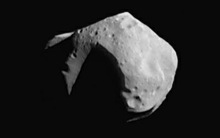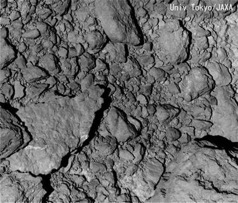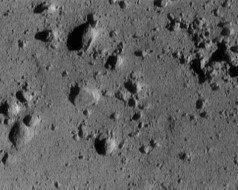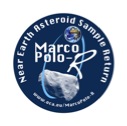Primitive asteroids
 The only image of a primitive dark type asteroid (Mathilde, 50 km, NEAR mission, NASA/APL). A study of the asteroid's albedo (brightness or reflective power) shows that it reflects three percent of the Sun's light, making it twice as dark as a chunk of charcoal. Such a dark surface is believed to consist of carbon-rich material that has not been altered by planet-building processes, which melt and mix up the solar system's original building block materials.
The only image of a primitive dark type asteroid (Mathilde, 50 km, NEAR mission, NASA/APL). A study of the asteroid's albedo (brightness or reflective power) shows that it reflects three percent of the Sun's light, making it twice as dark as a chunk of charcoal. Such a dark surface is believed to consist of carbon-rich material that has not been altered by planet-building processes, which melt and mix up the solar system's original building block materials.
Asteroids with low albedo are believed to be composed of the most primitive materials. They are found in the C, D, P and other dark taxonomic classes. So far, no space mission has visited a dark asteroid, while two space missions were devoted to the visit of the asteroids belonging to the more evolved S taxonomic class: the rendezvous NEAR mission (NASA) to the asteroid Eros and the sample return Hayabusa mission (JAXA) to the asteroid Itokawa. While the two objects belong to the same class, they showed totally different surface properties (see Figures below). This should not be a surprise as if gravity is the discriminant, then the 500 m-size Itokawa should be as different from the 23 km-size Eros, geologically, as Eros is from the Moon! Therefore, asteroids are extremely diverse, even within one taxonomic class, and should be even more different from one class to another.
Primitive asteroids are expected to contain organic materials. The possibility offered by MarcoPolo-R to identify and analyze the structure of the organics matter in laboratory in a great level of details is crucial to determine whether these objects delivered the prebiotic material that led to the formation of Life on Earth.

Surface of Itokawa: gravels and pebbles, no fine grains (JAXA)
Surface of Eros: fine dusty regolith, large boulders (NASA)
